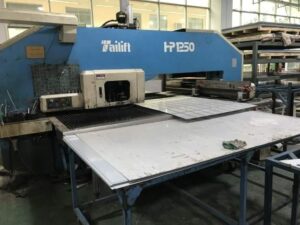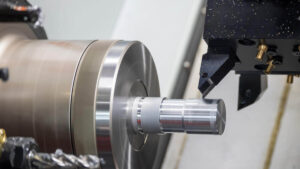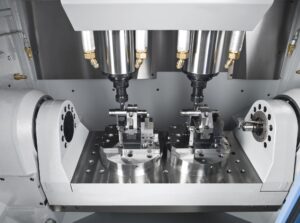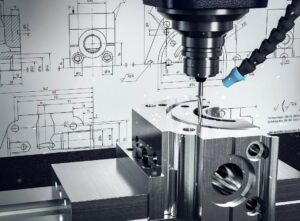Machining is a process of changing the shape or performance of workpieces with processing machinery. Remove excess material in a controlled manner to produce the desired part. Therefore, machining is also called subtractive manufacturing, and the workpiece is always larger than the finished part. Machining processes allow for greater precision than alternative technologies such as additive manufacturing.
According to the temperature state of the workpiece being processed, it is divided into cold processing and hot processing. Generally, it is processed at room temperature and does not cause chemical or phase changes of the workpiece, which is called cold processing. Generally, processing at higher or lower than normal temperature will cause chemical or phase changes of the workpiece, which is called thermal processing. Cold processing can be divided into cutting processing and pressure processing according to the difference in processing methods. Thermal processing commonly includes heat treatment, forging, casting and welding.
Conventional processing typeTurning: In a turning operation, the workpiece is rotated about a central axis. The turning tool performs linear or curved translational motion processing on the rotating workpiece. Turning can make the workpiece achieve the desired shape, which is suitable for processing shafts and rotary parts. Example: machine parts such as grooves, threads, shafts, holes, engine parts, etc.
Milling: Mainly use high-speed rotating tools to cut workpieces fixed on the workpiece table, suitable for machining planes, grooves, various curved surfaces or gears.
Grinding: The workpiece is mainly ground, outer circle, inner hole, and tools through a high-speed rotating grinding wheel. The surface roughness of the processed workpiece is particularly high, which is a secondary processing process to improve the surface finish; the surface grinder can improve the dimensional accuracy of the workpiece . Generally used in surface treatment, descaling, deburring, precision machining, etc.
Pliers: The fitter workbench is a basic tool and operation in mechanical manufacturing for precise measurement, inspection of dimensional accuracy and shape error of parts, and precision scribing;
Drilling: punching holes in workpieces with tools such as drill bits;
Boring: the processing of holes with boring tools or blades, suitable for holes with high precision and large diameter workpieces;
Planer: use planer to process plane or curved surface, which is suitable for processing the straight surface of the workpiece to make the entire surface of the workpiece smooth, but the roughness of the processed surface is not as high as that of the milling machine;
Punch: Stamped and formed by a punching machine, such as punching a circle or punching a hole;
Saw: Use a cutting tool to cut the workpiece, suitable for cutting after blanking;
Knurling: Knurling is a surface finishing process in which knurl pins are rolled across the surface of a workpiece to form a vertical, horizontal or criss-cross grid. Knurling can improve the aesthetics of the workpiece and increase the friction of the part. Often applied to tool handles, or surface treatments.
Unconventional processing typeEDM: Cutting a workpiece using electrical pulses of high voltage frequency. The arc created by the pulses melts the material in the desired location. This produces highly precise cuts. This method is only suitable for cutting conductive materials. It is mainly used in mold manufacturing such as holes and cavities in mold production.
Chemical processing: usually refers to the chemical technology method that uses acid, alkali or salt to remove surface metal by chemical reaction and process mechanical parts into a certain shape and size. When the workpiece is immersed in the chemical reagent, only the area to be removed is in contact with the reagent, and the rest is covered. This process can produce thorough cutting and engraving. It can be applied to processing highly thin parts, parts of automobiles and aircrafts, etc.
Plasma arc processing: a special processing method that uses the heat energy of the plasma arc to cut, weld and spray metal or non-metal. Often used in cutting stainless steel alloys, metal profile cutting, etc.
Laser processing: Laser processing technology is a processing technology that uses the characteristics of the interaction between laser beams and substances to perform cutting, welding, surface treatment, drilling and micro-processing of materials (including metals and non-metals). As an advanced manufacturing technology, laser processing has been widely used in automobiles, electronics, electrical appliances, aviation, metallurgy, machinery manufacturing, etc.

Ultrasonic Machining: Ultrasonic machining uses high-frequency vibrating tools to remove workpiece material. Abrasive substances are present between the tool and the workpiece. Mix the abrasive with water to form a fine abrasive paste. High-frequency vibrating tools use abrasive paste on the tip to remove material. Applications of ultrasonic processing include processing sensitive materials, glass cutting, optical instruments, electrical equipment, etc.
There are many types of mechanical processing. In addition to the above-mentioned daily mechanical processing processes, there are also some uncommon processing technologies, such as ion beam processing, water jet processing, abrasive jet processing, and electrochemical processing.
The difference between conventional processing technology and other processing technology
- Different cutting tools Traditional machining operations rely on carbide or high-speed steel metal alloy tools. Unconventional machining operations rely on other means such as hydraulics, electric heat, chemical reactions or friction of abrasive particles.
- Ease of Finished Shapes Traditional machining processes use solid cutting tools for simple shapes. Therefore, the types of shapes it can process are limited. Unconventional machining operations can machine highly complex shapes.
- Processing efficiency Conventional cutting processes are more efficient than unconventional ones. This is because the cutting tool can act directly on the workpiece over a large area. Unconventional processes must melt or corrode the workpiece at the particle level, resulting in slower cutting speeds.
- Cost Routine machining operations are cheaper than non-routine ones. Unconventional processing needs to rely on complex equipment, and technicians with special skills to operate increase the manufacturing cost.
- Precision The precision of conventional machining processes is limited by the minimum thickness of the tool. But unconventional processing technology can reduce the thickness to the microscopic level through laser, water or electric arc, and the precision of processing parts is very high.
Aixi is a professional machining manufacturer. We have a professional programming team and a complete set of machining equipment: five-axis, four-axis, three-axis CNC machining centers, CNC lathes, punching machines, boring machines, hobbing machines, bending machines, Laser cutting machine and 2D projector etc. Our company is a supporting one-stop processing manufacturer in the true sense of casting and processing integration.

 Deutsch
Deutsch Français
Français 日本語
日本語 Español
Español


